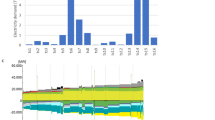Abstract
In this first part of a two-part article, the principal characteristics of the TIMES model and of its global incarnation as ETSAP-TIAM are presented and discussed. TIMES was conceived as a descendent of the MARKAL and EFOM paradigms, to which several new features were added to extend its functionalities and its applicability to the exploration of energy systems and the analysis of energy and environmental policies. The article stresses the technological nature of the model and its economic foundation and properties. The article stays at the conceptual and practical level, while a companion article is devoted to the more detailed formulation of TIMES equations. Special sections are devoted to the description of four optional features of TIMES: lumpy investments, endogenous technology learning, stochastic programming, and the climate module. The article ends with a brief description of recent applications of the ETSAP-TIAM model.
Similar content being viewed by others
References
Berger C, Dubois R, Haurie A, Lessard E, Loulou R, Waaub J-Ph (1992). Canadian MARKAL: an advanced linear programming system for energy and environment modelling. INFOR 20:114–125
Dantzig GB (1963). Linear programming and extensions. Princeton University Press, Princeton
Drouet L, Edwards NR, Haurie A (2006). Coupling climate and economic models: a convex optimization approach. Environ Models Assess 11:101–114
Finon D (1974). Optimization model of the French energy sector. Energy Policy 2(2):136–151
Fishbone LG, Abilock H (1981). MARKAL, a linear programming model for energy systems analysis: technical description of the BNL version. Int J Energy Res 5:353–375
Fishbone LG, Giesen G, Hymmen HA, Stocks M, Vos H, Wilde D, Zoelcher R, Balzer C, Abilock H (1983) Users guide for MARKAL: a multi-period, linear programming model for energy systems analysis. BNL Upton, NY, and KFA, Julich, BNL 51701
Kanudia A, Loulou R (1998). Robust responses to climate change via stochastic MARKAL: the case of Québec. Eur J Oper Res 106:15–30
Labriet M (2006) Quelle contribution des nouvelles technologies de transport aux stratégies climatiques à long terme? Modélisation et analyse technico-économiques. Colloquium “Transport, energy and greenhouse gases: will rationing be necessary?” 19èmes Entretiens du Centre Jacques Cartier, Lyon (France), December 4–5, 2006
Labriet M, Loulou R, Kanudia A (2006) Is a 2°C warming achievable under high uncertainty? Analysis with the TIMES integrated assessment model. Climate Policy (Under review)
Loulou R, Kanudia A (1999). Minimax regret strategies for greenhouse gas abatement: methodology and application. Oper Res Lett 25:219–230
Moomaw WR, Moreira JR (2001) Technological and economic potential of greenhouse greenhouse gas emissions reduction. In: Climate change 2001: Mitigation. Metz B, Davidson O, Swart R, Pan J (eds) Intergovernmental Panel on Climate Change (IPCC), Third Assessment Report, Working Group III Cambridge University Press, Cambridge pp 167–299
Nakicenovic N (ed) (2000) Special report on emissions scenarios A special report of working III of the intergovernmental panel on climate change. Cambridge University Press, Cambridge, p 599
Nordhaus WD, Boyer J (1999) Roll the DICE again: economic models of global warning. Yale University, Manuscript edition
Papadimitriou CH, Steiglitz K (1982). Combinatorial optimization—algorithms and complexity. Prentice-Hall, New-Jersey
Remme U, Labriet M, Loulou R, Blesl M (2006) Global energy supply: model-based scenario analysis of resource use and energy trade. International energy workshop, EMF/IEA(ETSAP)/IIASA, Cape Town (South Africa), June 27–29, 2006
Samuelson PA (1952). Spatial price equilibrium and linear programming. Am Econ Rev 42:283–303
Takayama T, Judge GG (1971). Spatial and temporal price and allocation models. North Holland, Amsterdam
Vaillancourt K, Labriet M, Loulou R, Waaub JP (2006) The role of nuclear energy in long-term climate scenarios: an analysis with the World-TIMES model. Energy Policy (Under review)
van der Voort E, Donni E, Thonet C, Bois d’Enghien E, Dechamps C, Guilmot JF (1984) Energy supply modelling package EFOM-12C Mark I, Mathematical description. Commission of the European Communities, Louvain-la-Neuve, EUR-8896
Author information
Authors and Affiliations
Corresponding author
Rights and permissions
About this article
Cite this article
Loulou, R., Labriet, M. ETSAP-TIAM: the TIMES integrated assessment model Part I: Model structure. CMS 5, 7–40 (2008). https://doi.org/10.1007/s10287-007-0046-z
Published:
Issue Date:
DOI: https://doi.org/10.1007/s10287-007-0046-z




